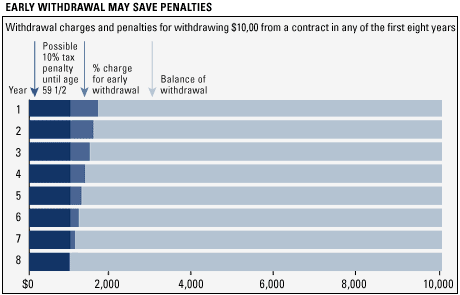|
Annuity fees are deducted directly from your account, and as a result, they will influence your return.
While the fees explained below generally apply to variable annuities, some may also apply to fixed annuities. There may also be other fees, so be sure to read the contract or the variable annuity prospectus carefully.
In most cases, the "M & E" charge pays for three important features: the guaranteed death benefit; once you've annuitized, the guarantee to provide an income you can't outlive; and the guarantee that contract expenses won't increase. These guarantees ensure that: (1) your beneficiaries will be protected if you die while still accumulating assets; (2) you'll have an income for as long as you live; and (3) some expenses will never rise beyond the amounts stated in your contract.
These are annual charges (sometimes called contract fees) to cover the costs of record keeping for your annuity, providing you with statements and other communications, and performing other operations.
This covers the costs of the professionals who manage the investment portfolios.
This may be charged to cover your licensed financial professional's commission. Many annuities don't have a sales charge, so 100% of your money can begin working right away to help your annuity value grow faster.
Let's assume that Donna, a hypothetical investor, makes an initial investment of $10,000 in a variable annuity. Here's how annual fees might affect her account value if she invests in an equity portfolio subaccount.
| Contract
value |
|
$10,000 |
$14,641 |
$23,577 |
| Sales
charge |
0% |
0 |
0 |
0 |
| Average
administrative charge |
0.17% |
17 |
25 |
40 |
| Average
management fee |
0.81% |
81 |
119 |
191 |
| Average
mortality and expense risk charges |
1.12% |
112 |
164 |
264 |
| Average
annual contract maintenance charges* |
$30 |
30 |
30 |
30 |
| Total |
|
$240 |
$338 |
$525 |
| |
|
|
|
|
Some contracts allow you to take a partial withdrawal, sometimes up to 15%, without contract penalties. When withdrawn earnings are taxed as ordinary income, and if you're not yet age 59½, there may be an additional 10% federal income tax penalty. Be sure to carefully read and understand the terms of your particular contract before you purchase it.
If you withdraw your money during the early years of the contract (usually during the first seven or eight years of the contract), the issuing company may keep a certain percentage of your withdrawals to cover the cost of issuing the contract. This is sometimes also known as a surrender charge, and may be assessed on a declining percentage basis. In the first year, for example, excess withdrawals may be subject to a 7% charge; in the second year 6%; then 5% in the third; and so on.

|